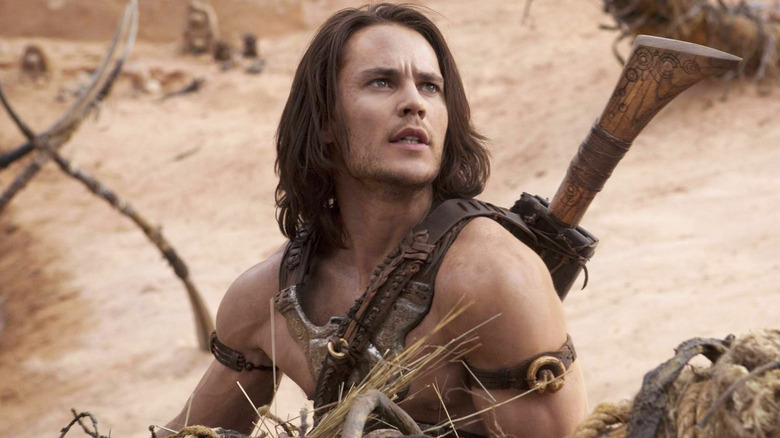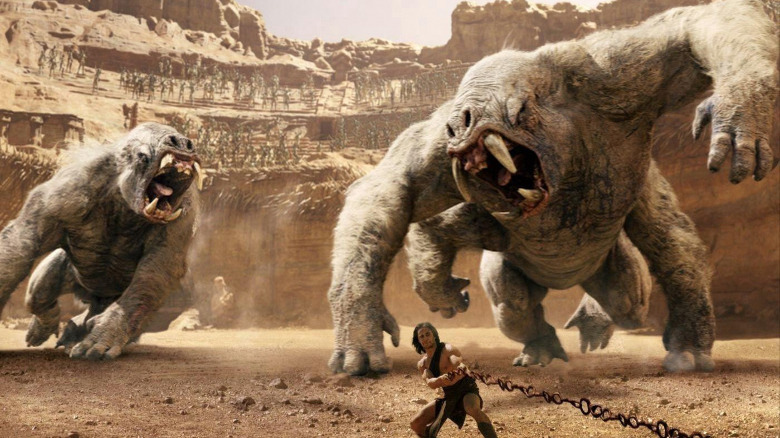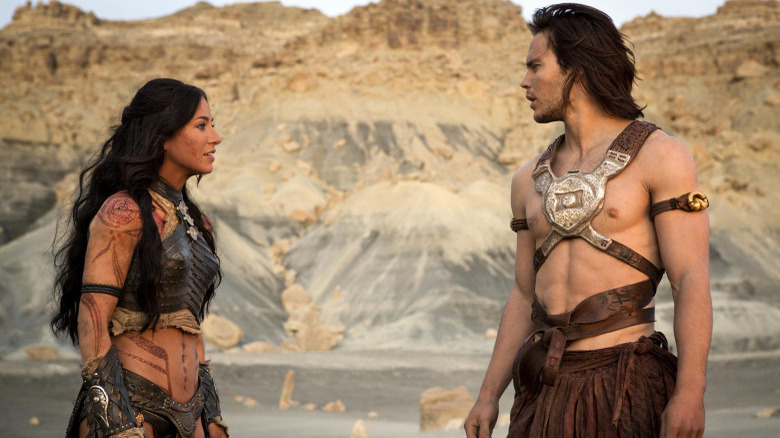The Daily Stream: John Carter Is A Vestige Of Spunkier Disney Tentpoles
(Welcome to The Daily Stream, an ongoing series in which the /Film team shares what they've been watching, why it's worth checking out, and where you can stream it.)
The Movie: "John Carter"
Where You Can Stream It: Disney+
The Pitch: It's 1868, and haunted U.S. Civil War veteran John Carter (Taylor Kitsch) wants nothing more than to find enough gold in the Arizona territory for him to live out the rest of his days alone. While fleeing a group of Union soldiers who want John's help in hunting down a local Apache group, he's accidentally transported to the planet Mars, which its natives call Barsoom. There, John lands smack dab in the middle of yet another war — this one between the Red Martian cities of Helium and Zodanga — and is taken in by a tribe of Green Martians known as the Tharks. Can John bring peace to this dying world (and, in doing so, himself) before it's too late?
"John Carter" came along at a time of transition for Disney. The Mouse House's animation department was starting to focus exclusively on computer-animated films, while the studio at large was on the hunt for a live-action franchise that could replicate the success of "Pirates of the Caribbean." At the behest of Andrew Stanton, who was coming off helming Pixar's "Finding Nemo" and "WALL-E," Disney acquired the rights to the Barsoom novels created by Edgar Rice Burroughs. Stanton would make his live-action directing debut on "John Carter" in 2012, a year that promised to evolve Kitsch from "Friday Night Lights" alum to the next big thing thanks to the triple-punch release of "John Carter," "Battleship," and "Savages."
Alas, it wasn't meant to be.
Why it's essential viewing
Both a notoriously costly film to make and an equally infamous box office flop, "John Carter" is not without its faults. The film can't escape the white savior trappings of Edgar Rice Burroughs' source material, "A Princess of Mars," and its world-building is a tad wonky at times. On top of that, Andrew Stanton's movie (which he co-penned with "Brave" co-director Mark Andrews and "Spider-Man 2" scribe Michael Chabon) would rather that you didn't dwell on the fact that John fought for the Confederacy (!) and all this may imply about him.
With those caveats out of the way, there's an underlying (if you will forgive the pretentious wording) cinematic quality to "John Carter" that's allowed it to stand the test of time better than other tentpoles from 10 years ago, purely in terms of its visuals. Stanton's background in animation shines through in the movie's best scenes, like a waggish montage where John stages multiple escape attempts after being captured by Union soldiers. A similarly playful, inventive sequence later in the film shows John as he clumsily adjusts to Mars' low gravity, slowly realizing he can leap great distances across the red planet.
Working with cinematographer Dan Mindel ("Star Trek," "Star Wars: The Force Awakens"), Stanton combines the gravelly textures of a Western with the striking aesthetic of a pulp sci-fi epic, making the movie's fantastical vision of Mars feel more alive and tactical. By mixing real-world locations in southern Utah with studio sets and green screens, the spectacle in "John Carter" also comes across as fittingly massive in scope for an interplanetary narrative of this nature. Compared to the directors behind certain recent $200 million+ projects (naming no names!), Stanton delivered a whole lot more bang with the bucks Disney gave him.
An earnest spectacle
For as undeniably trope-y as it is, "John Carter" is almost shockingly earnest in the way it approaches those tropes. Lynn Collins as the sword-swinging princess by day, scientist on the side Dejah Thoris is afforded the respect she deserves as a character (by both John and the film alike), and the same goes for the movie's portrayal of the Tharks and their culture (a familiar analogy for Native Americans, but a respectful one all the same). There's never a sense that the movie is laughing at its own subject matter, either, nor does it feel the need to have John offer snarky commentary about the plot. Turns out, a little sincerity goes a long way in this context.
Above all else, there's a welcome spunkiness to "John Carter" that's been absent from so many of the Mouse House's in-house live-action movies from the past 10 years. The battle scenes are often surprisingly vicious, and it's hard to remember the last time a Disney film had a scene as brutal as the one where John ruthlessly fights an onslaught of Tharks while flashing back to him finding and burying his dead family. Even the Therns, led by Mark Strong (in peak bad guy form) as Matai Shang, make for unexpectedly cunning, weird, and just plain interesting villains as the puppet-masters pulling the strings on the warring Red Martians.
The most ironic part? After a decade of superhero movies and "Star Wars" films, "John Carter" — itself adapted from source material that directly inspired so many of those things — comes across as more refreshing and less derivative now than when it was first released. By failing to launch the franchise Disney wanted, its legacy is instead that of a critical turning point in the evolution of the studio's blockbusters.


